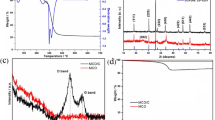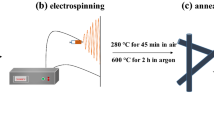Abstract
MoO2@N-doped C nanofibers (MoO2@NC NFs) were synthesized by electrospinning with polyacrylonitrile as carbon source. The in situ formed MoO2 nanocrystals are completely embedded in the carbon nanofibers, which can not only accelerate ion transition, but also act as a buffer to avoid the mechanical degradation of active material due to the volume changes during charge/discharge cycling. When used as the anode material for both Li/Na-ion batteries, the as-synthesized MoO2@NC NFs displayed excellent Li+/Na+ storage properties. As the anode for Li-ion battery, the MoO2@NC NFs display a high discharge capacity of 930 mA h g−1 at a current density of 200 mA g−1 for 100 cycles, and 720 mA h g−1 at a current density of 1 A g−1 for 600 cycles. Moreover, the discharge capacity of 350 mA h g−1 could be realized at a current density of 100 mA g−1 for 200 cycles for Na-ion battery.
摘要
以聚丙烯腈(PAN)作为碳源, 利用静电纺丝方法成功合成了二氧化钼/氮掺杂碳纳米纤维(MoO2@NC NF). 制备MoO2@NC NF过程中, 原位形成的MoO2纳米晶体被完全嵌入碳纳米纤维, 不仅能加速电子转移, 而且还作为缓冲层, 避免在充/放电循环过程中由于体积变化引起活性材料在碳纳米纤维中机械降解. 当MoO2@NC NF材料用作锂/钠离子电池的负极材料时, 展示出极好的储锂/钠性能. 作为锂离子负极材料, MoO2@NC NF 在电流密度为200 mA g−1的条件下, 经过100次循环后容量为930 mA h g−1; 当电流密度为1 A g−1, 其600次循环后容量为720 mA g−1. MoO2@NC NF用作钠离子负极材料, 在电流密度为100 mA g−1的条件下, 经过200次循环过程后, 其容量稳定在350 mA h g−1左右.
Similar content being viewed by others
References
Xu J, Ma J, Fan Q, et al. Recent progress in the design of advanced cathode materials and battery models for high-performance lithium-X (X = O2, S, Se, Te, I2, Br2 ) batteries. Adv Mater, 2017, 29: 1606454
Mao F, Guo W, Ma J. Research progress on design strategies, synthesis and performance of LiMn2O4-based cathodes. RSC Adv, 2015, 5: 105248–105258
Yang F, Zhu Y, Li X, et al. Crystalline TiO2@C nanosheet anode with enhanced rate capability for lithium-ion batteries. RSC Adv, 2015, 5: 98717–98720
Lan T, Wang T, Zhang W, et al. Rutile TiO2 mesocrystals with tunable subunits as a long-term cycling performance anode for sodium-ion batteries. J Alloys Compd, 2017, 699: 455–462
Lu Y, Zhou P, Lei K, et al. Selenium phosphide (Se4P4) as a new and promising anode material for sodium-ion batteries. Adv Energ Mater, 2017, 7: 1601973
Wang L, Sun YG, Hu LL, et al. Copper-substituted Na0.67Ni0.3−x-CuxMn0.7O2 cathode materials for sodium-ion batteries with suppressed P2–O2 phase transition. J Mater Chem A, 2017, 5: 8752–8761
Zhou L, Wu HB, Wang Z, et al. Interconnected MoO2 nanocrystals with carbon nanocoating as high-capacity anode materials for lithium- ion batteries. ACS Appl Mater Interfaces, 2011, 3: 4853–4857
Zeng L, Huang X, Chen X, et al. Ethanol thermal reduction synthesis of hierarchical MoO2–C hollow spheres with high rate performance for lithium ion batteries. RSC Adv, 2016, 6: 105558–105564
Tang S, Ouyang B, Yang L, et al. Synthesis of MoO2 hierarchical peony-like microspheres without a template and their application in lithium ion batteries. RSC Adv, 2015, 5: 50705–50710
Palanisamy K, Kim Y, Kim H, et al. Self-assembled porous MoO2/graphene microspheres towards high performance anodes for lithium ion batteries. J Power Sources, 2015, 275: 351–361
Sun Y, Hu X, Luo W, et al. Ultrafine MoO2 nanoparticles embedded in a carbon matrix as a high-capacity and long-life anode for lithium-ion batteries. J Mater Chem, 2012, 22: 425–431
Zhou Y, Liu Q, Liu D, et al. Carbon-coated MoO2 dispersed in three-dimensional graphene aerogel for lithium-ion battery. Electrochim Acta, 2015, 174: 8–14
Guan J, Zhao L, Xing C, et al. Novel flexible MWCNTs@MoO2-C nanocable composites with excellent electrochemical performance for lithium ion battery anodes. Mater Res Express, 2015, 2: 095502
Tang W, Peng CX, Nai CT, et al. Ultrahigh capacity due to multielectron conversion reaction in reduced graphene oxide-wrapped MoO2 porous nanobelts. Small, 2015, 11: 2446–2453
Mei L, Mao M, Chou S, et al. Nitrogen-doped carbon nanofibers with effectively encapsulated GeO2 nanocrystals for highly reversible lithium storage. J Mater Chem A, 2015, 3: 21699–21705
Zhang Y, Yang Y, Gu Y, et al. Performance and service behavior in 1-D nanostructured energy conversion devices. Nano Energ, 2015, 14: 30–48
Xiang J, Yu XY, Paik U. General synthesis of vanadium-based mixed metal oxides hollow nanofibers for high performance lithium- ion batteries. J Power Sources, 2016, 329: 190–196
Li X, Chen Y, Huang H, et al. Electrospun carbon-based nanostructured electrodes for advanced energy storage–a review. Energ Storage Mater, 2016, 5: 58–92
Teo WE, Ramakrishna S. A review on electrospinning design and nanofibre assemblies. Nanotechnology, 2006, 17: R89–R106
Lu X, Wang C, Wei Y. One-dimensional composite nanomaterials: synthesis by electrospinning and their applications. Small, 2009, 5: 2349–2370
Tang X, Wei Y, Zhang H, et al. The positive influence of graphene on the mechanical and electrochemical properties of SnxSb-graphene- carbon porous mats as binder-free electrodes for Li+ storage. Electrochim Acta, 2015, 186: 223–230
Guo W, Mei L, Li X, et al. Electrospun In@C nanofibers as a superior Li-ion battery anode. RSC Adv, 2015, 5: 92522–92525
Joshi BN, An S, Kim YI, et al. Flexible freestanding Fe2O3-SnOx-carbon nanofiber composites for Li ion battery anodes. J Alloys Compd, 2017, 700: 259–266
Samuel E, Jo HS, Joshi B, et al. Decoration of MnO nanocrystals on flexible freestanding carbon nanofibers for lithium ion battery anodes. Electrochim Acta, 2017, 231: 582–589
Kar A, Kundu S, Patra A. Surface defect-related luminescence properties of SnO2 nanorods and nanoparticles. J Phys Chem C, 2010, 115: 118–124
Zhu Y, Xu X, Chen G, et al. Surfactant-free self-assembly of reduced graphite oxide-MoO2 nanobelt composites used as electrode for lithium-ion batteries. Electrochim Acta, 2016, 211: 972–981
Xie X, Lin L, Liu RY, et al. The synergistic effect of metallic molybdenum dioxide nanoparticle decorated graphene as an active electrocatalyst for an enhanced hydrogen evolution reaction. J Mater Chem A, 2015, 3: 8055–8061
Wang S, Zhao Y, Li C, et al. Local-ordering MoO2 nanostructures within porous N-doped carbon nanotubes for high-rate reversible lithium storage. J Alloys Compd, 2017, 695: 1285–1293
Nie G, Lu X, Chi M, et al. CoOx nanoparticles embedded in porous graphite carbon nanofibers derived from electrospun polyacrylonitrile@ polypyrrole core–shell nanostructures for high-performance supercapacitors. RSC Adv, 2016, 6: 54693–54701
Wang H, Dou S, Wang S, et al. Synthesis of electrocatalytically functional carbon honeycombs through cooking with molecule precursors. Int J Hydrogen Energ, 2017, 42: 6472–6481
Schniepp HC, Li JL, McAllister MJ, et al. Functionalized single graphene sheets derived from splitting graphite oxide. J Phys Chem B, 2006, 110: 8535–8539
Chen WC, Chen CH, Tseng HW, et al. Surface functionalized electrospun fibrous poly(3-hydroxybutyrate) membranes and sleeves: a novel approach for fixation in anterior cruciate ligament reconstruction. J Mater Chem B, 2017, 5: 553–564
Li Y, Wang Z, Li L, et al. Preparation of nitrogen and phosphorous co-doped carbon microspheres and their superior performance as anode in sodium-ion batteries. Carbon, 2016, 99: 556–563
Gu X, Wu F, Lei B, et al. Three-dimensional nitrogen-doped graphene frameworks anchored with bamboo-like tungsten oxide nanorods as high performance anode materials for lithium ion batteries. J Power Sources, 2016, 320: 231–238
Shen J, Hu W, Li Y, et al. Fabrication of free-standing N-doped carbon/TiO2 hierarchical nanofiber films and their application in lithium and sodium storages. J Alloys Compd, 2017, 701: 372–379
Wang L, Yang C, Dou S, et al. Nitrogen-doped hierarchically porous carbon networks: synthesis and applications in lithium-ion battery, sodium-ion battery and zinc-air battery. Electrochim Acta, 2016, 219: 592–603
Kang W, Zhang Y, Fan L, et al. Metal–organic framework derived porous hollow Co3O4/N–C polyhedron composite with excellent energy storage capability. ACS Appl Mater Interfaces, 2017, 9: 10602–10609
Guo W, Li X, Xu J, et al. Growth of highly nitrogen-doped amorphous carbon for lithium-ion battery anode. Electrochim Acta, 2016, 188: 414–420
Maldonado S, Morin S, Stevenson KJ. Structure, composition, and chemical reactivity of carbon nanotubes by selective nitrogen doping. Carbon, 2006, 44: 1429–1437
Sun Y, Hu X, Luo W, et al. Self-assembled hierarchical MoO2/graphene nanoarchitectures and their application as a high-performance anode material for lithium-ion batteries. ACS Nano, 2011, 5: 7100–7107
Ma Y, Jia Y, Wang L, et al. Facile synthesis of three-dimensional flower-like MoO2–graphene nanostructures with enhanced electrochemical performance. J Mater Chem A, 2016, 4: 10414–10418
Zeng L, Zheng C, Deng C, et al. MoO2-ordered mesoporous carbon nanocomposite as an anode material for lithium-ion batteries. ACS Appl Mater Interfaces, 2013, 5: 2182–2187
Xia G, Liu D, Zheng F, et al. Preparation of porous MoO2@C nanooctahedrons from a polyoxometalate-based metal–organic framework for highly reversible lithium storage. J Mater Chem A, 2016, 4: 12434–12441
Yang LC, Sun W, Zhong ZW, et al. Hierarchical MoO2/N-doped carbon heteronanowires with high rate and improved long-term performance for lithium-ion batteries. J Power Sources, 2016, 306: 78–84
Wang Y, Yu L, Lou XWD. Formation of triple-shelled molybdenum- polydopamine hollow spheres and their conversion into MoO2/carbon composite hollow spheres for lithium-ion batteries. Angew Chem Int Ed, 2016, 55: 14668–14672
Petnikota S, Teo KW, Chen L, et al. Exfoliated graphene oxide/MoO2 composites as anode materials in lithium-ion batteries: an insight into intercalation of Li and conversion mechanism of MoO2. ACS Appl Mater Interfaces, 2016, 8: 10884–10896
Wang Y, Huang Z, Wang Y. A new approach to synthesize MoO2@C for high-rate lithium ion batteries. J Mater Chem A, 2015, 3: 21314–21320
Wang X, Xiao Y, Wang J, et al. Facile fabrication of molybdenum dioxide/nitrogen-doped graphene hybrid as high performance anode material for lithium ion batteries. J Power Sources, 2015, 274: 142–148
Hariharan S, Saravanan K, Balaya P. α-MoO3: a high performance anode material for sodium-ion batteries. Electrochem Commun, 2013, 31: 5–9
Huang J, Xu Z, Cao L, et al. Tailoring MoO2/graphene oxide nanostructures for stable, high-density sodium-ion battery anodes. Energ Tech, 2015, 3: 1108–1114
Acknowledgements
This work was supported by the National Natural Science Foundation of China (51302079).
Author information
Authors and Affiliations
Corresponding author
Additional information
Author contributions Liang J and Ma J designed the project. Liang J performed the main experiments. Gao X and Chen C put forward valuable suggestions. Guo J is responsible for the characterization of materials. Gao X and Fan K helped with the experiments. Liang J and Ma J analyzed the data and wrote the manuscript.
Conflict of interest The authors declare that they have no conflict of interest.
Supplementary information Supporting data are available in the online version of the paper.
Jiaojiao Liang is a PhD candidate in the School of Physics and Electronics, Hunan University. Her current research focuses on the synthesis of nanomaterials and their applications in lithium-ion and sodium-ion batteries.
Xian Gao is an undergraduate student at Hunan University. His current research is focused on the synthesis of nanomaterials and the preparation of devices.
Jianmin Ma is an associate professor in Hunan University, China. He received his BSc degree in chemistry from Shanxi Normal University in 2003 and PhD degree in materials physics and chemistry from Nankai University in 2011. During 2011–2015, he conducted the research in several oversea universities as a postdoctoral research associate. His research interest focuses on the synthesis of nanostructured materials, electrochemical storage devices, electrocatalysis, and gas sensors.
Electronic supplementary material
Rights and permissions
About this article
Cite this article
Liang, J., Gao, X., Guo, J. et al. Electrospun MoO2@NC nanofibers with excellent Li+/Na+ storage for dual applications. Sci. China Mater. 61, 30–38 (2018). https://doi.org/10.1007/s40843-017-9119-2
Received:
Accepted:
Published:
Issue Date:
DOI: https://doi.org/10.1007/s40843-017-9119-2




